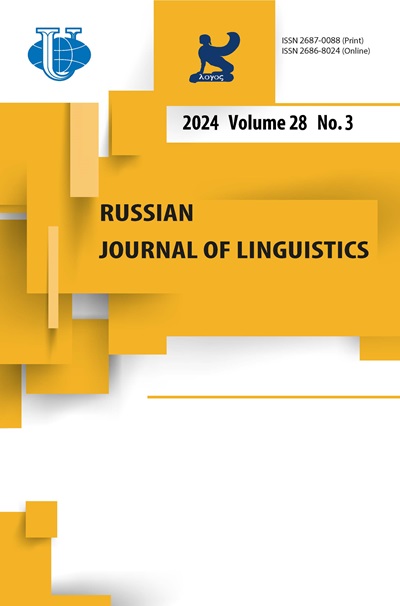Межкультурная коммуникация как продукт ситуативного комплексного взаимодействия
- Авторы: Карбо Д.1
-
Учреждения:
- Массачусетский университет
- Выпуск: Том 19, № 4 (2015)
- Страницы: 33-42
- Раздел: Статьи
- URL: https://journals.rudn.ru/linguistics/article/view/9255
Цитировать
Полный текст
Аннотация
Сфера межкультурной коммуникации включает в себя как разнообразные продуктивные теоретические, так и методологические подходы. Некоторые исследования основаны на данных самооценки, общих тенденциях и/или изучении данных внутри национальных общностей и между ними. В данной статье основное внимание уделено разным видам эмпирических исследований, основанных на наблюдении реального межкультурного взаимодействия и его интерпретации с точки зрения участников. В начале статьи рассматривается процесс межкультурного общения как результат ситуативного столкновения культур. Далее представлены четкие и взаимодополняющие методы анализа для каждой стадии исследования. В конце работы определяются специфические цели и перспективы исследования.
Ключевые слова
Об авторах
Донал Карбо
Массачусетский университет
Email: carbaugh@comm.umass.edu
Кафедра коммуникации
Список литературы
- Berry, Michael. (2009). The social and cultural realization of diversity: an interview with Donal Carbaugh. Language and Intercultural Communication, 9, 230-241.
- Carbaugh, Donal. (1990). The critical voice in ethnography of communication research. Research on Language & Social Interaction, 23(1-4), 261-281.
- Carbaugh, Donal. (1993). Cultural pragmatics and intercultural competence. The competent intercultural communicator: AFinLA Yearbook, 117-129.
- Carbaugh, Donal. (2005). Cultures in Conversation. Mahwah, NJ & London: Lawrence Erlbaum Publishers.
- Carbaugh, Donal. (2007). From cognitive dichotomies to cultural discourses: Hofstede, Fougere and Moulettes in conversation. Journal of Multicultural Discourses, 2, 20-25.
- Carbaugh, Donal. (2015). Reporting cultures on 60 Minutes: Missing the Finnish line. Routledge.
- Carbaugh, Donal and David Boromisza-Habashi. (2015). Ethnography of communication. International Encyclopedia of Language and Social Interaction Blackwell. 537-552.
- Carbaugh, Donal and Tovar Cerulli. (2013). Cultural Discourses of Dwelling: Investigating Environmental Communication as a Place-based Practice. Environmental Communication: The Journal of Nature and Culture 7 (1), 2013, 4-23.
- Carbaugh, Donal, Molina-Markham, Elizabeth, Nuciforo, Elena, & van Over, Brion. (2011). Discursive reflexivity in the ethnography of communication: Cultural discourse analysis. Cultural Studies Critical Methodologies, 11, 153-164.
- Carbaugh, Donal, Nuciforo, Elena, Saito, Makoto, & Dong-Shin, Dong. (2011). Cultural discourses of “dialogue”: The cases of Japanese, Korean and Russian. Journal of International and Intercultural Communication, 4, 87-108.
- Chen, Victoria. (1990/1991). “Mien tze” at the Chinese dinner table: A Study of the Interactional Accomplishment of Face. Research on Language and Social Interaction, 24, 109-140.
- Covarrubias, Patricia. (2008). Masked silence sequences: Hearing discrimination in the college classroom. Communication, Culture& Critique, 1, 227-252.
- Hall, Bradford “J”. (1994). Understanding intercultural conflict through an analysis of kernel images and rhetorical visions. International Journal of Conflict Management, 5, 62-86.
- Hymes, Dell. (1972). Models of the interaction of language and social life. In J. Gumperz and Dell Hymes (eds.), Directions in sociolinguistics: The ethnography of communication (pp. 35-71). New York: Holt, Rinehart and Winston.
- Katriel, Tamar. (2004). Dialogic moments: From soul talks to talk radio in Israeli culture. Detroit, MI: Wayne State University Press.
- Klyukanov, Igor and Olga Leontovich. (in press). Russian perspectives on communication. In D. Carbaugh (ed.), Handbook of Communication in Cross-cultural Perspective (International Communication Association Series). Routledge.
- Philipsen, Gerry, Coutu, Lisa M., & Covarrubias, Patricia. (2005). Speech codes theory: Restatement, revisions, and response to criticisms. In W. Gudykunst (ed.), Theorizing about intercultural communication Sage. 55-68.
- Witteborn, S. (2010). The role of transnational NGOs in promoting global citizenship and globalizing communication practices. Language and intercultural communication, 10(4), 358-372.

















